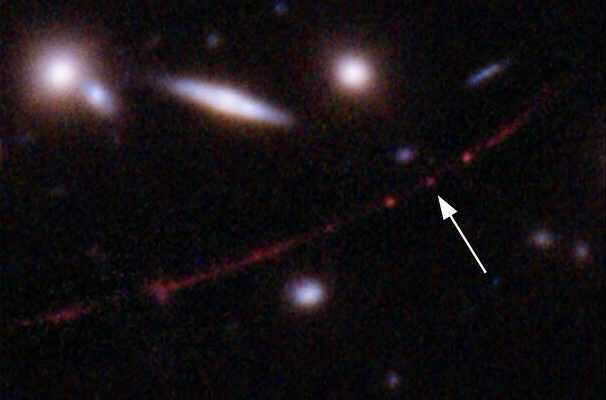A scientific team publishes in the journal Nature the detection of an extraordinarily distant star, whose light took 12.9 billion years to reach us! It is the most distant ever observed, and its discovery was only possible thanks to Hubble and an exceptional gravitational lensing effect.
Astrophysicists hope to confirm the discovery with measurements from the telescope.
Thank you lenses
” At first, we didn’t even believe it, it was so much further away than the previous stars observed, shifted in the red! explains Brian Welch, astrophysicist and main author of the article published in Nature. The light from this star took so long to reach us that with the expansion of the universe and the Doppler effect, its light spectrum shifted “into the red” (this is the red shiftin English, here with a value of 6.2).
Discovered by Hubble during a distant observation campaign, this star surprised scientists. Indeed at this distance, entire galaxies generally appear as points, and entire star clusters cannot be resolved. But this time, thanks to a gravitational lensing effect (a massive object or galaxy distorts light and allows a Spyglass effect behind it), scientists observed a galaxy named ” The Sunrise Arc (the Arc of the Rising Sun), within which, magnified more than a thousand times by the lens effect, they detected this star.
A primordial star?
Nicknamed Earendel (the morning star, in old English… but also an assumed reference to the Silmarillon by JRR Tolkien after B. Welch), it has long been extinct, since its light took 12.9 billion years to reach us. As long as it is observable, it will become an exciting subject of study, because this star is very massive (50 times the size of our Sun and several million times brighter).
Moreover, it would be from the generation of primordial stars, this first or second generation of stars with very short lives after the Big Bang, composed of very light elements only (hydrogen, helium, traces of lithium). ” Studying Earendel will open a window into a period of our universe not known to us, but leading to all we know. It’s a bit like reading a very interesting book, but missing the first chapter, and now we have a chance to find out where it all started “, details B. Welch.
Need a big telescope…
If the discovery raises few doubts, it will however be necessary to refine the measurements (and check for example that it is not a question of a very dense group or cluster of stars, or of a duo of binary stars). Future Hubble observations are planned, but the team is already counting on the James Webb telescope, which should start its scientific campaigns from this summer.
The latter will easily observe Earendel, and will in theory be able to better document it, and therefore better understand its age, mass and composition. Will he be able to see even more distant stars? However, this is not guaranteed: here, it was not so much Hubble’s performance that enabled the discovery as this incredible gravitational lensing effect that “brings” us closer to the past.
Source: ESA

12